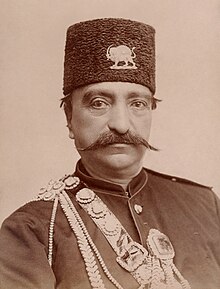This article needs additional citations for verification. (May 2019) |
| Naser al-Din Shah Qajar ناصرالدین شاه قاجار | |||||
|---|---|---|---|---|---|
| Shahanshah of Iran Zell'ollah (Shadow of God [on earth])[1] Qebleh-ye 'ālam (Pivot of the Universe)[1] Islampanah (Refuge of Islam)[1] | |||||
 Naser al-Din Shah, photographed by Nadar in 1889 | |||||
| Shah of Iran | |||||
| Reign | 5 September 1848 – 1 May 1896 | ||||
| Predecessor | Mohammad Shah Qajar | ||||
| Successor | Mozaffar ad-Din Shah Qajar | ||||
| Regent | Malek Jahan Khanom | ||||
| Premiers | |||||
| Born | 17 July 1831[2] Kahnamu, Persia | ||||
| Died | 1 May 1896 (aged 64) Tehran, Persia | ||||
| Burial | |||||
| Spouse | 85 women, among them: | ||||
| Issue | See below | ||||
| |||||
| Dynasty | Qajar | ||||
| Father | Mohammad Shah Qajar | ||||
| Mother | Malek Jahan Khanom | ||||
| Religion | Shia Islam | ||||
| Tughra |  | ||||
Naser al-Din Shah Qajar[3] (Persian: ناصرالدینشاه قاجار, romanized: Nāser-ad-Din Ŝāh-e Qājār; 17 July 1831 – 1 May 1896) was the fourth Shah of Qajar Iran from 5 September 1848 to 1 May 1896 when he was assassinated. He was the son of Mohammad Shah Qajar and Malek Jahan Khanom and the third longest reigning monarch in Iranian history after Shapur II of the Sassanid dynasty and Tahmasp I of the Safavid dynasty. Nasser al-Din Shah had sovereign power for close to 51 years.
He was the first modern Persian monarch who formally visited Europe and wrote of his travels in his memoirs. A modernist, he allowed the establishment of newspapers in the country and made use of modern forms of technology such as telegraph, photography and also planned concessions for railways and irrigation works. Despite his modernizing reforms on education, his tax reforms were abused by people in power, and the government was viewed as corrupt and unable to protect commoners from abuse by the upper class which led to increasing anti-governmental sentiments. He was assassinated when visiting a shrine in Rayy near Tehran.
- ^ a b c Amanat, Abbas (1997), Pivot of the Universe: Nasir Al-Din Shah Qajar and the Iranian Monarchy, 1831–1896, Comparative studies on Muslim societies, I.B. Tauris, p. 10, ISBN 9781860640971
- ^ "Nāṣer al-Dīn Shāh | Qājār Shah of Iran, Assassination & Legacy | Britannica".
- ^ Naser al-Din is pronounced as Nāser-ad'din, and less formally as Nāser-ed'din.